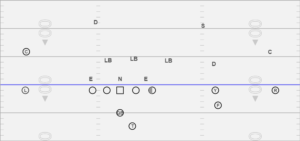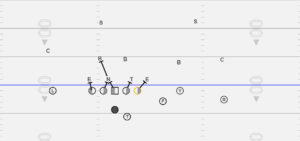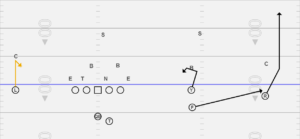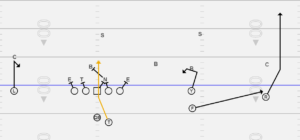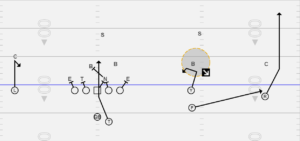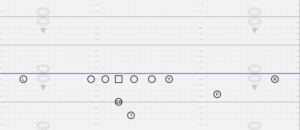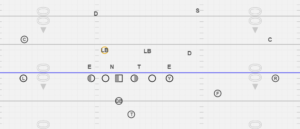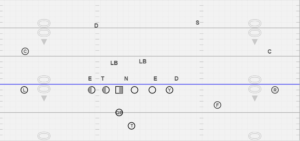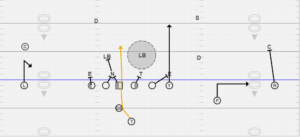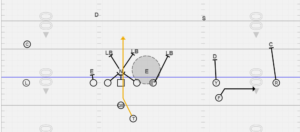The Inside Zone RPO is your favorite play. This week’s Defensive coordinator knows this. So he will spend all week devising ways to take away the Inside Zone RPO. He will drill his players on how to stop the Inside Zone RPO. And his defense will stop it for a drive.
It will happen. Trust me. It’s football. But what will you do when it happens? Will you stop running the play?
Hell no.
You will run this amazing variation off of the Inside Zone RPO and have the defensive coordinator quit on the spot.
The Inside Zone RPO Blocking Scheme.
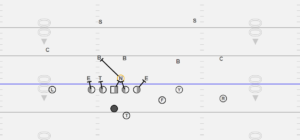
Blocking Inside Zone Against a Shade.
The blocking scheme is the same as before. And that is what makes the Inside Zone RPO blocking scheme so amazing. It keeps things simple upfront for your offensive linemen. This lets your offensive linemen play hard, fast, and be successful
Left Tackle – You block anyone head up to outside of you.
Left Guard – You will check the play side B-gap. If there is someone there then you will block them. If there is no one there then you will check the backside A-gap. If you have someone in that gap then you will block them. If you do not have anyone in either gap then the center must be covered and you will help out the center.
Center – You will check the play side A-gap. If you have someone in the gap then you will block that person. If no one is in that gap then you will check the back side A-gap. If you have someone in that gap then you will block that person. If there is no one in either gap then that means you are covered and you will block the person over you.
Right Guard – You will check the play side A-gap. If you have someone in that gap then you will block that person. If you don’t have anyone in the play side A-gap then you will check the back side B-gap. If there is someone in that gap then you will BASE BLOCK HIM, because you are now apart of the BASE tag. If no one is in either gap then the center must be covered and you will help him.
Right Tackle – You will block anyone head up to outside of you because you are tagged with the BASE tag.
The Wide Receivers Routes in Inside Zone RPO
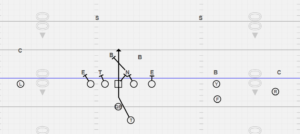
Defenses will put a man right over the stack receiver.
This is where the variation comes from. If you gash the defense a couple of times with the Stick route off of the Inside Zone RPO, then the defense will put a guy on top of the Y receiver and press him at the line of scrimmage.
That’s fine. Because that will help free up the F receiver.
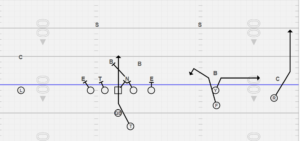
Run F Stick and have the defensive coordinator quit during the game.
L Receiver - You are running a hitch/fade read route. If the corner is five yards off of you then you will run a three step hitch. Expect the ball when you turn around. If the corner is in your face then you will take a mandatory outside release and run to the end zone.
Y Receiver - You are going to attack the outside shoulder of the man over you. Your job is for the man to place his hands on you. Make him turn his shoulders and chase you. If you can, grab his jersey a little bit and force him to come with you.
F Receiver - You are running five hard steps towards the inside shoulder of the defender over the Y receiver. If the Y does his job right then there shouldn’t be a defender there. Doesn’t matter. Take a mental imagine and attack the shoulder. Hitch up and look for the ball on your inside shoulder after the fifth step. The ball will be coming fast so don’t be surprise.
R Receiver - You are running a mandatory outside release vertical. You will take your man to the end zone. If you stop running and let the corner into the play then you can expect to sit the bench for the rest of the game.
Running Back Steps in the Inside Zone RPO
Running Back’s foot work is the same as before. You are taking a six inch search step with the foot closest to the quarterback. This is called a Search Step.
You will cross over with your opposite foot and point your toes towards the center’s butt on your second step. This is called a Cross Over Step.
You will come downhill towards the center’s butt on your third step. This is called the Go step.
If the quarterback pulls the ball from you then you will attack the backside linebacker.
This is a cheap way of turning the run blocking into a form of pass blocking.
Quarterback’s Read in the Inside Zone RPO
The quarterback is asking himself this question when you call the Inside Zone RPO: How many people are in the box?
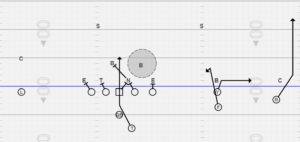
Quarterback’s read in the Inside Zone RPO.
If the quarterback sees six men in the box then he knows the offense doesn’t have the advantage in the run game. So he will move his read to the linebacker over the Y receiver.
If the linebacker follows the Y receiver then the quarterback will throw the ball to the F receiver. If the linebacker chases the F receiver then the quarterback will throw the ball to the Y receiver.
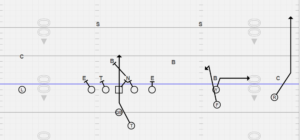
Hand the ball off against a five man box.
If the quarterback sees five defenders in the box then he knows the offense has run advantage. He will hand the ball off to the running back and FAKE A THROW to hold the secondary. This gives the running back an advantage.
That’s it
All you have to do to confuse the defense and have the defensive coordinator sweating at night is change up the wide receiver’s routes. Nothing changes for the offensive linemen or the quarterback’s read. That’s the beauty of this offense. We keep things simple so the kids can play fast and be successful.
Leave a comment below if you do anything different with your Inside Zone RPOs. I love to hear from ya’ll. Please subscribe to my YouTube channel if you haven’t already. I put out a new video every Saturday morning. Please download my FREE One Back Power RPO eBook. The sign up is at the top of the page.
Until next week coaches, let’s continue to Master the Spread, Score Points, and Have Fun.
